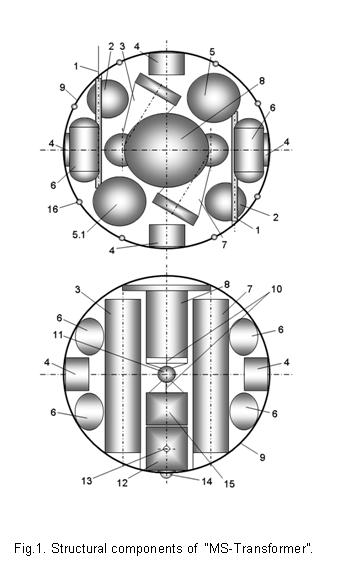
ORBITING AND DEORBITING OF THE SATELLITE BY AEROSPACE PLANE
A. S. Levenko, V. I. Kukushkin
The project proposal of creation of the Ukrainian two-stage aerospace plane (ASP) ōSuraö [1] provides for the opportunity of orbiting a returnable and reusable satellite. It is needed for creation of orbital groupings of satellites, their maintenance and servicing in the orbit, forming the grouping and providing their efficiency while in an orbit, including a change of a number of satellites in the grouping. ASP returns the satellite back to the Earth with the purpose of reducing the ōspace debrisö in the Earth space and also costsÆ reduction of the space researches by way of possible reuse of the returned spacecraft (satellite).
1. Transportation of the satellite of spherical shape. ASP payload bay
While creating the orbital spacecraft ōSpace Shuttleö, its payload bay reportedly was designed for a certain military satellite. Hence there are such big dimensions of the payload bay of the ōSpace Shuttleö.
The same principle can be applied to the orbital plane ASP ōSuraö [2, 3], i.e. the payload bay is being designed for all possible HWD of its potential load.
There are two variants under consideration: transportation of the reusable prospective satellite (satellites) and transportation of the other loads (materials, space equipment and the labs, working in an orbit. Transportation of the special loads can be of certain specific character.
In the general case, the universal satellite, which is carried to the orbit by the aerospace plane, in case of multiple deliveries must meet the acceptable typical conditions of its transportation; and for its deorbiting ¢ simplified conditions of deorbiting and fixing the satellite in the payload bay for its transportation.
It is well known the method of transportation of the Soviet unified satellites ōTaifunö [4]. The no oriented satellite was made of a spherical framework, in which there were connected two halves. For fixing the spacecraft in the rocket vehicle and its separation in an orbit there was used the method of its fastening, which provides for the use of the undercarriage and four articulated two-lever arms (ōTaifun-1Bö).
The satellite was of spherical shape, convenient for transportation.
There is also well-known spacecraft ōTaifun-2ö of the same type (modification of the spacecrafts ōTaifun-1ö and ōTaifun-1Bö, in which there is used the method of space orientation with triaxial magnetic-gravitational gyroscopic system [4].
It can be considered a spherical micro-satellite with the diameter of 0,5 m and the weight of 20-75 kg, which is being specially developed for the ASP, for which there can be designed a payload bay [5]. Fig.1 shows possible structural layout of such satellite.
2. Withdrawal of the satellite from ASP
The development of the multi-purpose satellite can provide not only serviceability for its transportation, but also its proper orientation in the space [6]. Fig.2 features the method of jet-propelled separation of the satellite from the plane with concurrent satellite orientation.
The satellite outer surface (static state is shown on part I) consists of two hemispheres (1) and of the surface of the weight of the gravitational navigation and stabilizing system (2) ¢ stabilizing weight. The satellite is fixed in the payload bay in its starting position in the holes ½└╗ and ½┴╗ and by fastening the satellite on its spherical surface while transportation by four articulated two-lever arms, as on its prototype ¢ the satellite of the ōTaifunö type. Stabilizing weight is removing jet engine with the nozzles (3), directed to the satellite center. At the command the engine is starting and the stabilizing weight (2) separates from the satellite (state is shown on part II), pulling the cable (4). The stabilizing weight moves away by the thrust of the engine for a distance up to 1,2-5 km from the satellite along the local vertical line. In this case the launch vehicle is pre-oriented in the space for satellite axis orientation. During removal of the stabilizing weight, the cable (rope) is unreeled and hindered because of friction, and the satellite is removed from the payload bay. Separation of the satellite takes place without any force on the launch vehicle and due to that, the satellite does not change its orientation in the space.
It has been realized the method of self-dependent removal of the satellite.
After that (if necessary) the satellite takes its ōready-to-workö position. This transformation is realized without time limitation with minimal speed, which does not change its orientation in the space. It is guaranteed high-precision orientation of the satellite in the space? Which is necessary for its functioning (the analogs are considered in the publications [7, 8, 9].
Gravitational renewable moment (M), which arises due to satellite axis deviation from angular orbital position, when mean angular speed is q, cable length is L, stabilizing weight ¢ m is described by the formula:
M = q2 L2 m sin(a),
- where (a) is angular deviation of the satellite axis from its balanced orbital position.
The construction of such satellite allows transforming it back to a spherical shape: its hemispheres join together again; stabilizing weight takes its initial position by the cable.
This spherical satellite can be inserted and fixed in the space plane and then it can be returned from an orbit to the Earth.
The suggested method can be applied to the micro-, nano- or femto-satellite (i.e. satellites with the weight 10-100kg, 1-10kg, 0,1-1kg and less, than 0,1kg) as a reusable satellites for sounding the Earth surface with different purposes (economic, scientific etc., for providing telecommunication and other orbital task [5, 10]). For orbiting, deorbining and returning the satellite to the Earth can be used aerospace plane
[1, 2, 3].
NEXT
|